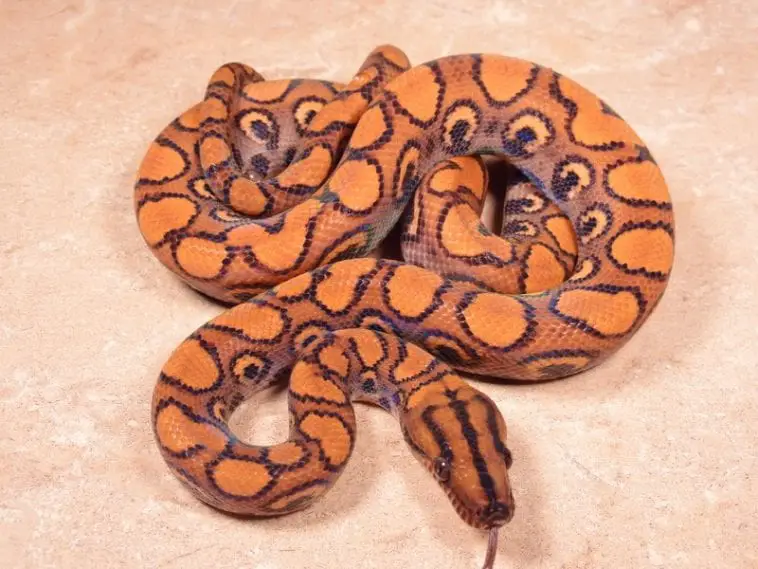Scientific Facts
| Common Name | Rainbow boa, Brazilian rainbow boa |
| Scientific Name | Epicrates cenchria |
| Life Span | In the wild, can live up to 10 years, in captivity, up to 30 years |
| Size | Length of 4 to 6 feet, the weight of 2 to 3 pounds |
| Habitat | Terrestrial, found near water, rainforests, humid woodland, open savannas |
| Country of Origin | Central and South America |
Physical Description
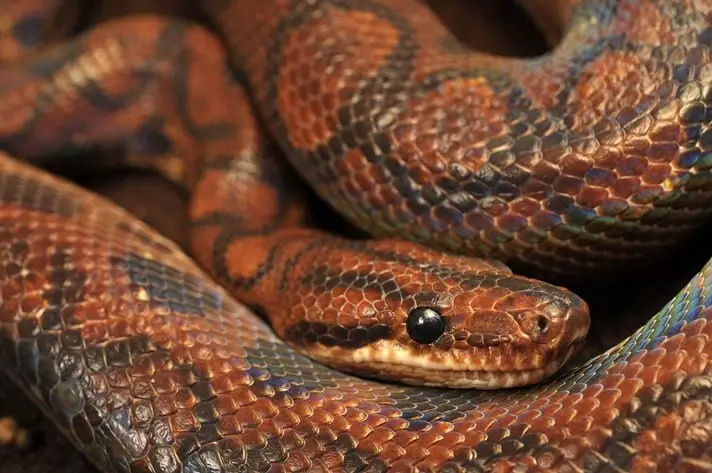
The Brazilian rainbow boa is one of the largest of the rainbow boas. It is native to Central and South America. These are beautiful and colorful snakes that call the Amazon basin of Southern Venezuela, Brazil, coastal Guyana, Suriname and French Guiana their home.
Also called rainbow boas, these are a part of the Boidae family where around 40 more species are part of including the boa constrictor and green anaconda. Experts say that all boas are primitive snakes because these snakes still have vestigial back legs that look like small spurs along the sides of the cloaca.
These are terrestrial snakes found near bodies of water. But actually, the habitat of the rainbow boa range from humid forests to dry open savannas. These have a prehensile tail that helps them climb and reach high areas but these are not arboreal species.
The rainbow snake is a medium-sized snake with a round body which can grow up to 6 feet in length. These can weigh around 3 pounds but can become heavier when cared for in captivity. The female Brazilian rainbow boa is larger than males. The large head is wider compared to the neck with three parallel black markings or stripes.
The skin is soft and lovely, with a slight multicolored effect hence their name “rainbow” boa. If you think that the scales are lovely, wait till these sheds because these will become shinier after shedding. The rainbow boa is brown or red-brown with huge blotches at the back.
According to many snake enthusiasts, the Brazilian rainbow boa is one of the loveliest and because of this, it is very popular in the exotic pet trade industry. It is also regarded as a moderate to difficult snake to take care of in captivity.
Rainbow boas are available at most exotic pet stores and from reptile stores online. When these snakes are younger, these are more prone to bite their handlers because of their natural defense mechanisms. But as they get used to being held, these naturally calm down.
Subspecies
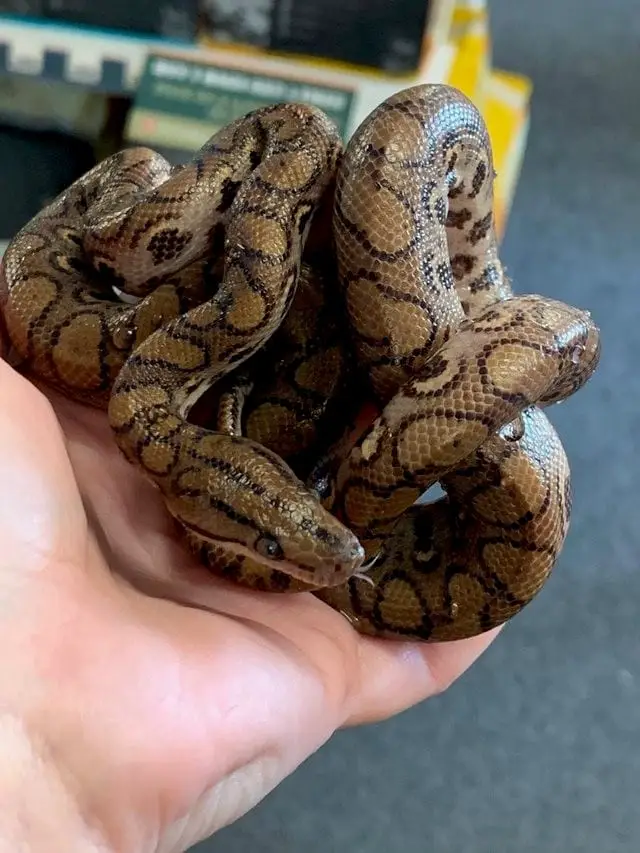
There are five known subspecies of the Brazilian rainbow boa.
- E. c. barbouri named by Stull in 1938. This is locally called Marajo Island rainbow boa
- E. c. cenchria named by Linnaeus in 1758. This is locally called Brazilian rainbow boa. This species is found in the Amazon Basin in Suriname, coastal Guiana, French Guyana and in southern Venezuela.
- E. c. gaiheae named by Stull in 1938. This is locally named Peruvian rainbow boa.
- E. c. hygrophilus by Amaral in 1935. This is locally called Espirito Santo rainbow boa.
- E. c. polylepsis by Amaral in 1935. This is locally named as Central highland rainbow boa.
Life Span
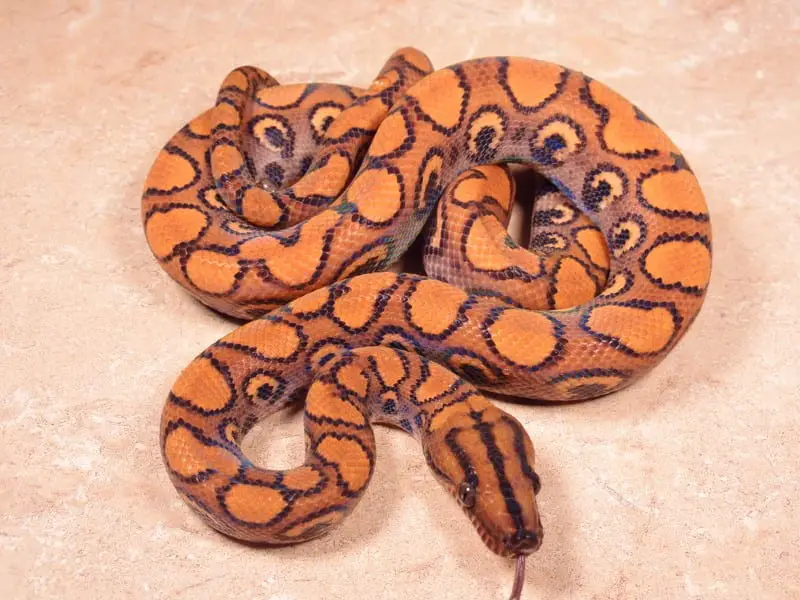
With the best care, rainbow boas in captivity can live for more than 20 years. There are reports of female rainbow boas that are still reproducing despite being 24 years old. During the 1980s and the early 90s, large numbers of Brazilian rainbow boas were exported from its native country of Suriname. Today, only a few are and most that are for sale from local and online shops are bred from captivity.
There are three life stages of the Brazilian rainbow boa
Hatchlings
The hatchlings develop inside egg sacs found in the female’s body. These hatch inside the female and are born alive. A clutch may have 12 to 15 hatchlings. When these arrive, these are hungry and ready to eat anything. Baby rainbow boas don’t receive any parental care and usually, these will be ready to hunt for food in a week.
Young/juveniles
Within a year, young snakes can double their lengths and their weights. These young snakes now look very much like their parents but have smaller markings on their bodies.
Adults
Adult rainbow boas’ sexual maturity is determined by its length and not by the snake’s age. Females are sexually mature when they grow 4.5 feet. Meanwhile, males are sexually mature when they reach 4 feet. More on the Brazilian rainbow boa’s sexual maturity and reproduction later.
Eating Habits
In the wild, rainbow boas will eat small mammals, birds, rodents, frogs, and lizards. In captivity, these will eat mice and rats. The rainbow boa is mostly terrestrial and is active at night. These snakes will actively look for prey at night not with its eyes but through unique heat-sensing pits near its jaw. This allows the snake to easily find prey even at the darkest night. This may also be the reason why snake hisses and bring out its long tongue.
Boas are constrictors which means that they will initially ambush their prey and coil around it. They have very sharp teeth that face backward which also help grip prey as they coil and squeeze. The rainbow boa has a very large and muscular body, therefore, it won’t be long when its prey dies. After their prey dies, they will start swallowing it from head to tail or the rear end. It can take hours for a boa to swallow its prey and this usually depends on the size.
After swallowing it whole, the boa rests and remains still as it slowly digests its food. It can take days to weeks to digest again depending on the size of the prey. At this time, leave the rainbow boa alone. It will feed again after a week. Keep a calendar or a schedule of your boa’s feeding routine to keep track of its food and appetite.
Sleeping Habits
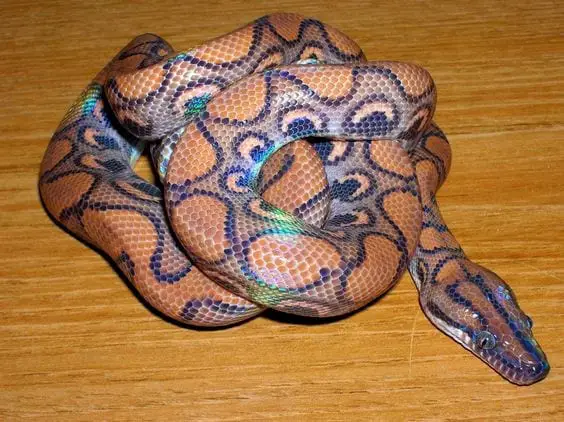
Rainbow boas are nocturnal and will hunt, eat and bask during the evening. It’s important to place the boa tank in a safe area in your home so it won’t be disturbed when it’s resting in the morning. Provide good lighting during the evening and schedule feeding and other activities like tank cleaning and maintenance in the evenings as well.
Water
Brazilian rainbow boas will drink water from a dish so keep a shallow one inside its tank. Replace the water in this dish every day so it won’t harbor dangerous bacteria which can affect your snake’s health. The water inside the tank is also a way to correct humidity inside the tank. You may also use a water mister to spray water on the side of the tank and foliage. The rainbow boa will lick this water. Good humidity levels inside the tank also help your snake shed its skin faster and with no complications.
Development and Reproduction
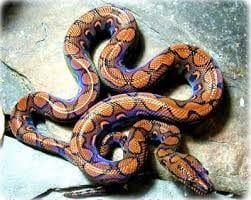
Rainbow boas are ovoviviparous species of snakes which means this snake will not lay eggs on nests. Instead, the babies will develop inside egg sacks found inside the body of the female. The hatchlings are born alive and ready to eat, hunt and explore.
The breeding season for Brazilian rainbow boas is from November to January. A clutch is composed of 12 to 25 hatchlings and can be male or females. The gestation period for rainbow boa hatchlings is around 5 months.
When the female Brazilian rainbow boa feels that she is ready to give birth, it will search for a quiet and secure place to lay her babies. She is very vulnerable at this time so it’s best to leave the snake alone and quiet.
But compared to other reptiles, the rainbow boa abandons her clutch after giving birth. But despite receiving no parental care, the hatchlings act on impulse and start to crawl on their own. These will start to hunt for small prey like rodents after a week.
Hatchlings already look like young rainbow boas once they come out of their mother. These will measure 15 to 20 inches long but after just a year will be around 36 to 40 inches long. As mentioned, the sexual maturity of Brazilian rainbow boas depends on its size.
How to Breed
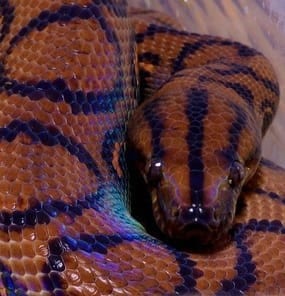
To successfully breed rainbow boas, you must start with a healthy male and female. Determine the sex of the rainbow boa first to avoid costly mistakes. Remember, don’t just rely on the pet store to give you male or female snakes, you must learn how to correctly identify the genders of your rainbow boas and to check after purchase.
You can probe, pop or palpate for the gender of your boa but most snake owners would prefer to probe. This is palpating, feeling for the boa’s hemipenes found along the tail. You can palpate immediately after the snakes are born.
How to palpate
Start feeling the area at the vent. Slide your fingers towards the tail and as you do, apply slight pressure along the dorsal and ventral surface using your forefinger and thumb. As you move one-third of the way to the tail tip, you will feel two bumps inside the tail.
This means that you’re holding a male. These are the tips of the hemipenes and will feel like grains of rice. Snake owners swear that palpating for the hemipenes is 95% successful and a lot less messy than popping or probe.
Remember that parent snakes should be healthy and large enough to breed and have good body condition. Females must be at least 2 ½ years to breed but you can also wait till 3 ½ to 4 ½ years for a mature female. Young females are more prone to suffer from breeding complications and may have trouble recovering from giving birth. Look for good girth, good muscle tone and the right weight for breeding success.
Breeding temperatures
Breeding season for rainbow boas is determined by different factors, among them is the light cycle. There must be shorter days and longer nights to breed. Use artificial lighting to accomplish this. Cooler temperatures will also signal to breed. Consider monitoring the temperature of your tank. There must be a warm spot or area in the tank at least a few hours daily.
Number of snakes to breed
A breeder recommends placing a trio of boas inside a breeding tank. You should have one male and two females so the male will have constant access to a female. Females may refuse to eat during the breeding season and even throughout the pregnancy. But despite this, feed only small food and more frequently if they refuse a one-time large meal.
Female rainbow boas will swell along their mid-bodies as she ovulates. Females may hang around a dish of water while some prefer to be by themselves in one corner of the tank. Some prefer to bask under the lamp longer so provide more heat in a day. You may add insulation inside the tank to preserve heat.
Rainbow boas will give birth at 90 days of incubation. When you think that the female is ready to give birth soon, remove a large amount of water in a tank or water dish. Rainbow boas prefer to give birth in water and deep water can drown hatchlings.
The babies are born inside their individual sacs. They will break this to get their first breath of fresh air. Other than the water, females may also use a moist area to give birth. The hatchlings may sometimes stay near their mother in a few hours after birth which may last for days.
These will scatter to different areas in the cage so make sure that their cages are secure and have no gaps or cracks where they can wiggle out. Some breeders report mothers eating unfertilized eggs while some say that this may not be true since mothers can be protective of their young.
Common Health Problems
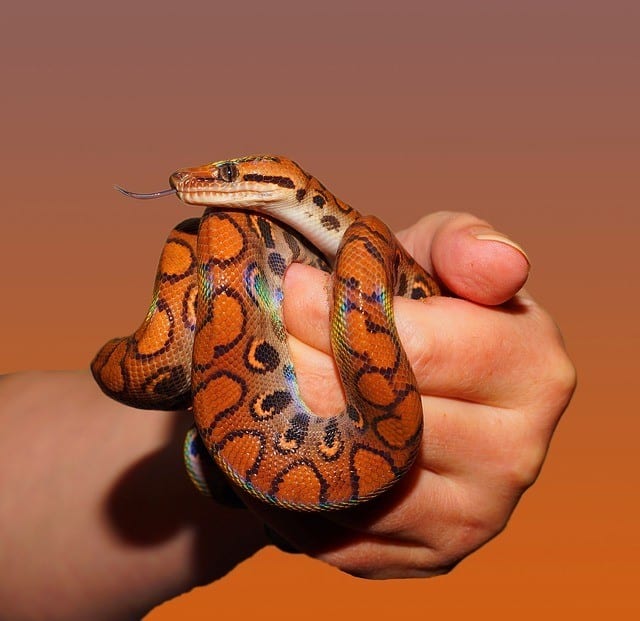
Snakes are easy to keep as pets and to make sure that these are healthy and with the right care and nutrition, you must identify signs that your pet is sick or unwell.
Pet boas are usually in a good state of health as long as it eats the right food and their cages well-maintained. However, sometimes these may not be enough to avoid the following health conditions.
Spotting healthy snakes
Overall, healthy snakes have clear eyes, clear nose, and mouth, eats regularly, sheds regularly and without any problems and have a rounded and full body. Pay attention to the skin; this should be smooth, without cuts or bruises. Snakes with health issues may have dry skin, are lethargic, with discharge from the nose or mouth, decreased appetite and vomiting and with abnormal feces or urine. If you notice any of these signs and symptoms, take your pet to a vet ASAP.
Common Health Issues
Here are the most common health issues of snakes which are also common in Brazilian rainbow boas.
Common skin conditions
Your pet rainbow boa may be affected by any kind of skin condition and the most common is an abscess. An abscess is due to a previous injury that has become infected by bacteria. This may look like a bump on the skin. This bump may protrude to the internal organs and usually, this is confused with tumors, constipation and unborn eggs.
Another condition is a blister which affects snakes. Blisters are fluid-filled skin structures that form along the underside of the snake. This is usually due to the snake living in a moldy, dirty or overused substrate. This must be removed by a vet because these may build up and grow the nose or mouth and can block breathing.
Another common skin conditions are cuts and blisters. This is preventable by making sure that the accessories inside the enclosure will never harm your python. Cuts may be treated by simple first aid as soon as possible to avoid contamination or blood loss. Deeper and more severe cuts should be taken to the vet.
Mites and ticks are tiny moving dots that can be color red, white or black. Ticks are larger and fewer and can attach itself in between the scales and will not be easy to remove. No matter what happens, do not remove the tick with tweezers, just soak the snake in a warm bath so that these parasites can detach from the skin. If the mite and tick multiply, consult your vet right away.
Constipation
Some factors can affect the digestion of food: the size of the snake and metabolic rate are just some of these. And if you think that it has been days or weeks from the last time your snake pooped then suspect constipation.
The first thing to do is to place your snake in warm water for 15 minutes a day. This will stimulate digestion and excretion. If constipation goes hand and hand with swelling of the belly, consult a vet at once.
Internal parasites
This is common especially when your snake is in the wild. A spotted python in the wild can pick up parasites from other reptiles also from infected prey. Signs of parasites include poor appetite, regurgitation, lethargy and an unwell appearance. Take your pet to the vet to check for internal parasites.
Regurgitation
Regurgitation happens when your snake is stressed or when it has been handled improperly or as soon after it has just eaten and an undiagnosed illness. This may be avoided by not holding your snake after feeding, Have your pet checked by the vet for any improperly treated illness.
To help your snake recover and to avoid recurrence, prepare a heated area inside the tank where it can remain after eating. Serve it smaller pieces of food to avoid regurgitation.
Respiratory conditions
If you notice lethargy, coughing, open-mouthed breathing runny noses, unusual clicking noises or wheezing, your snake may have some form of respiratory issues. Increase the temperature inside the tank to stimulate the immune response of your snake.
Move the enclosure to another part of the room or house away from other snakes. This area should be quiet so your snake can recuperate. Viral respiratory conditions will go away without treatment. All you need is rest and the right temperature. But if your snake’s condition worsens, take it to the vet right away.
Shedding problems
Shedding happens to all snakes and will be part of your rainbow boa’s life. Shedding may be a problem to snakes especially when the tank is not properly hydrated. The skin found in the body and tail is usually the easiest to shed. But the skin surrounding the eye or the eyecaps and tail can take time. This may cling to the body if it is too dry.
Use a mister and spray this inside the tank, on the accessories and body of the snake. You may also place a bowl of water in the tank to improve humidity. Snakes are usually paler skin before shedding. And as soon as you identify that your snake is shedding, soak this in warm water. Do this daily. For any complications of shedding, take your pet to the vet.
Preventing Illness
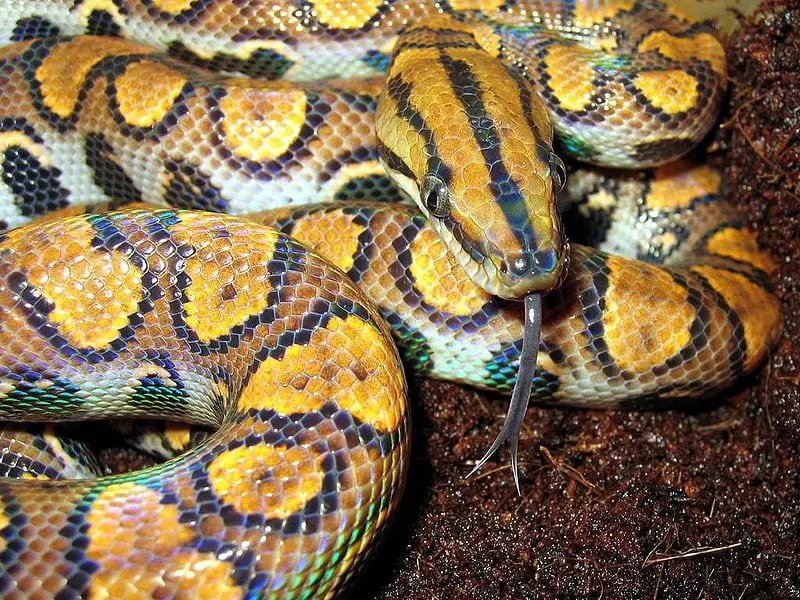
To prevent illness, make sure that the tank has the ideal temperature and hydration. Use the best tank lighting and humidifier available for snakes or reptiles. Use a digital thermometer and hygrometer to monitor tank health.
Have backup power like battery-operated lamps to prepare for power outages. Properly hydrate your rainbow boa by misting the tank with water. Place a bowl of water inside and be sure to change this water daily.
Change bedding to prevent parasitic and bacterial infections; don’t reuse bedding. Use suitable bedding for a boa which is moss, orchid bark or other similar materials. Don’t forget to inspect the area for rotting food and poop. If you overlook these, these may cause diseases and contamination.
Create a quarantine area to protect your boa. Never place it inside a tank or room with your other pets. Some infections are due to snakes and other reptiles in the wild. You must also take the new pet to the vet to ensure its health.
As you feed your pet rainbow boa, avoid wild-caught animals because these may have consumed plants with pesticides and this can harm your pet. Large food like mice and lizards can help give your pet supplements or multivitamins. Don’t overfeed your boa. Keep a calendar to monitor your snake’s feeding schedule.
When shedding, leave your rainbow boa alone. Intervene only when you see problems with shedding along the tail and the eyecap. You can avoid these by maintaining the right tank temperature and humidity inside the tank.
Behavior
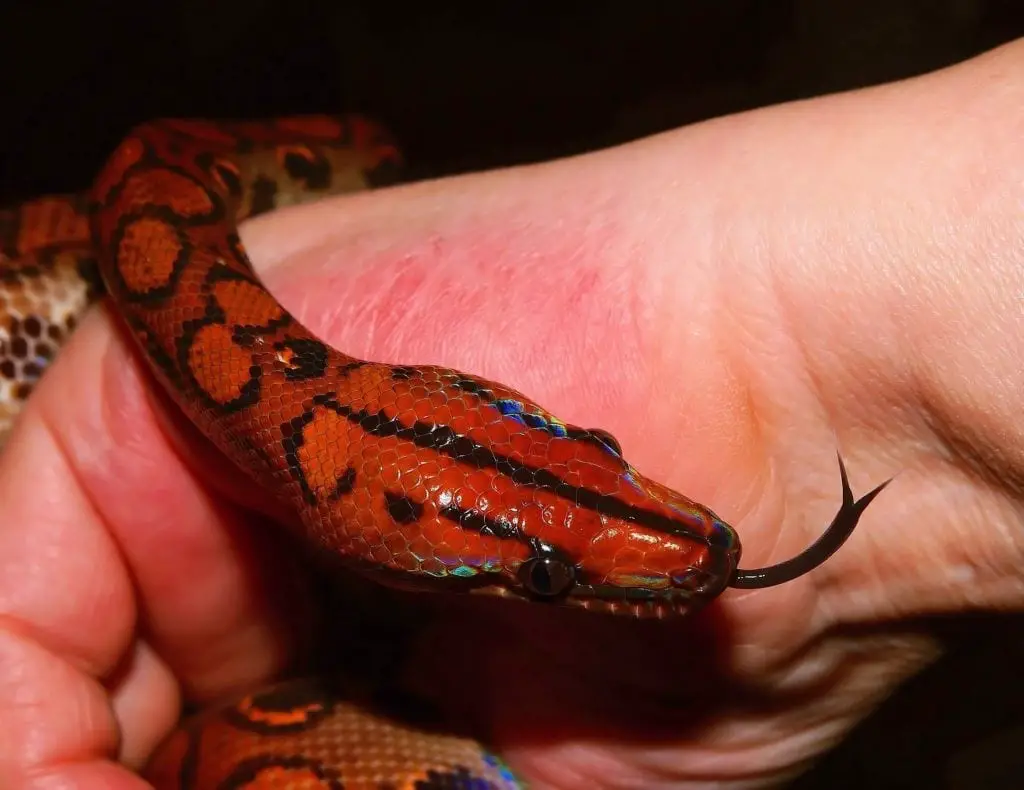
Get to know your Brazilian rainbow boa with the following behaviors common with the species:
Glowing skin
Although not a behavior, the most impressive characteristic of rainbow boas is their glowing skin. Use a low-wattage fluorescent lamp which should be mounted over the tank. This will bring out the natural rainbow color on your snake’s skin. This snake is nocturnal so you need to turn your ambient lights off to create a night cycle with 8 to 12 hours lighting schedule. Keep in mind that if you are using live plants inside your terrarium, ambient lighting would be a good choice.
Voracious eaters
Brazilian rainbow boas have a huge appetite, therefore, these will enjoy eating all kinds of food, frozen or live. Their diet is composed of a variety of small mammals, birds, rodents, bats and small lizards. When in captivity, an all-rodent diet would suffice. Rainbow boas coil around their prey and squeeze the life out of them. Give your boa time to eat their food which may take hours especially with larger food.
Generally docile
Rainbow boas are generally docile animals and thus may be cared for even by people new to taking care of snakes. This boa can also withstand regular handling. But don’t place it in a tank with other boas because the two might start to fight. The last thing you need is an injured snake because of a fight with another snake.
Nippy during the juvenile stage
During the juvenile stage, the rainbow boa may bite but this is not so worrisome. This behavior is simply the snake’s instinct. But as it turns older, rainbow boas will become tamer and will never bite even if you provoke it.
Great companions
The Brazilian rainbow boa is a good snake companion. It is tame, easy to handle and will never bite. The secret to raising a good-natured boa is early handling. Always take time to hold your boa before eating, before sleeping or just take it out of its tank for some fresh air.
If you recently got your snake, let it rest and recuperate before you start handling it. After a few days of feeding and resting, you may now hold it, carefully ensuring that your grip is not too tight but not too loose.
Shedding
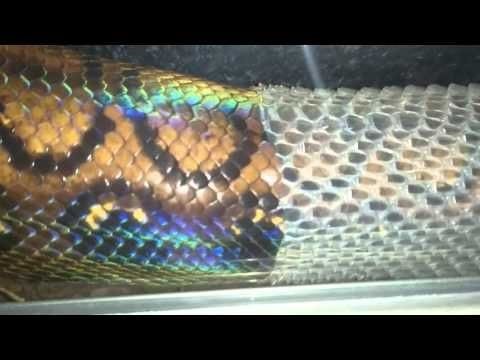
Shedding is a sign that your snake is growing well. Snakes shed at least once a month. During the shedding process, the skin gives way to accommodate the increasing size of the python, hence this is very important to growing snakes. Shedding happens more often in young or juvenile pythons and is less frequent in adults. If your boa is not shedding then this may be a sign of malnutrition or other medical issues.
One of the reasons why rainbow boas fail to shed or may not shed at all is stress, skin bacteria, over handling, skin bacteria, trauma or other conditions. When your snake is about to shed, the eyes swill become glazed and turn white. The skin will come out in one piece of incomplete and successful shedding.
Habitat
The color and texture of the substrate can help hide your snake so consider this defense mechanism. But in captivity, rainbow boas should be kept in enclosures 1.5 feet deep, 4 feet in width and about a foot high.
A larger cage may also be used and if you can’t find a large tank, you may do better with a made-to-order tank. This may be costly but will give your snake plenty of room.
A glass terrarium is better to keep humidity better. Place an insulator to avoid the escape of heat and humid air. Include accessories inside like perches, plants, and pots so your snake can perch and hide and where it can sleep and hibernate.
Never place two pythons inside a tank because these animals prefer solitary. If you plan to care for several pythons, use a basement, attic or garage to house your tanks.
Lighting and Humidity
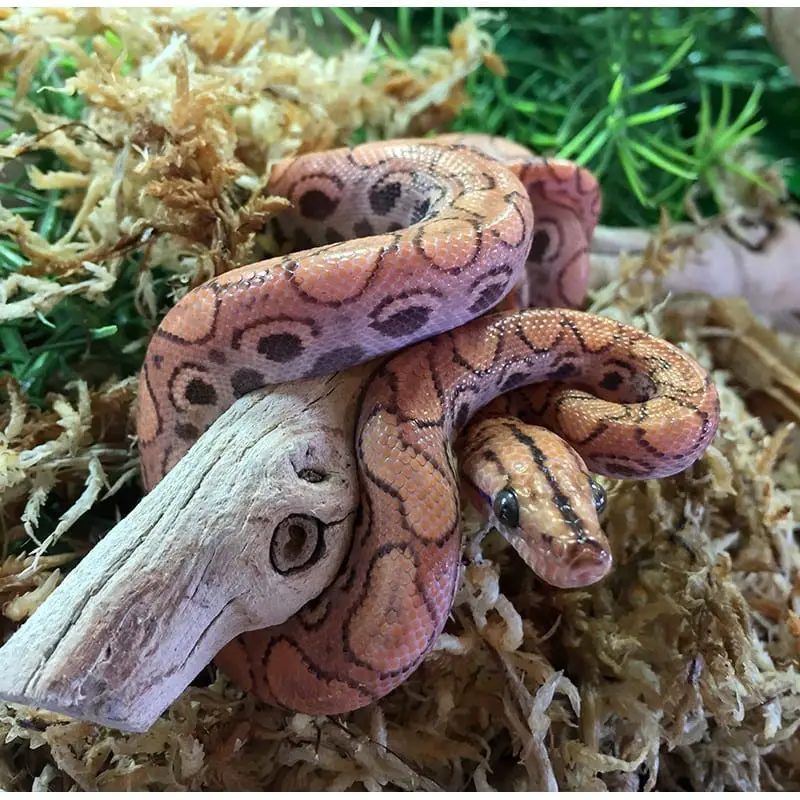
Use a lamp designed for reptile tanks. Maintain constant temperature inside the tank. It should be between 88 to 90 degrees Fahrenheit during the day and lower at nighttime. Manage the tank temperature and humidity constantly with a digital hygrometer and thermometer. Keep a pan of water inside the tank or spray water using a mister to increase humidity.
When it comes to lighting, what is best for rainbow boas? The LED lighting is the ideal lighting for a snake tank because of many reasons. LED lamps will shine brightly but will not shine so bright to make the tank too hot. LED bulbs can be very expensive but will last for a long time. LED bulbs are available in a variety of wattages and designs.
Choose an adjustable LED lamp. Be sure to have backup lighting with battery-powered lamps in case of long power outages.
Tank Bedding and Accessories
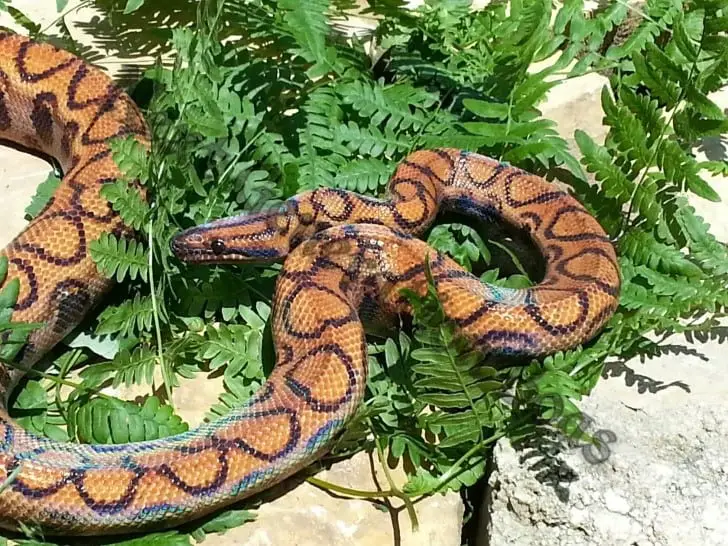
Remember that rainbow boas will mostly slide, slither and move against different surfaces inside its tank, therefore, this needs a safe and semi-soft bedding and accessories. Choose smooth rocks, easy to clean surfaces and odor-free materials in your snake tank.
Follow the rainbow boa’s coastal habitat. Choose soft surfaces, smooth rocks or orchid barks as bedding. No matter what type you use, you must spot check the bedding daily to maintain tank cleanliness.
Install natural or artificial plants and perching ledges inside the tank. Make sure that these don’t have sharp edges which can scratch or cut the resident boa.
Sanitation
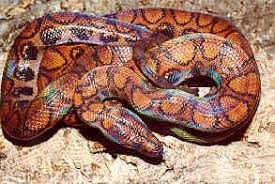
A clean tank enhances the health of your rainbow boa. Clean the snake tank thoroughly and use natural cleaning products as much as possible. Natural cleaning products could be everyday items you have in your kitchen like lemon, baking soda or vinegar. These are very common natural ways to remove dirt, grime, and smell without any dangerous components that can affect your boa’s health.
For commercially-prepared chemical products, follow directions on the product label. Always rinse the tank well and afterward, dry with paper towels before you take the accessories back. Clean the accessories and remove dying leaves and rotting plant parts. If the plants seem to be dying or too hydrated, remove and replace these.
Sometimes it’s better to install artificial plants and perches because you can wash these when you clean the tank. Also, artificial plants won’t wilt and rot which is another thing that can affect tank health.
You’ll find a wide variety of cleaning products that you can use to maintain your rainbow boa tank. You can choose from disinfectants, sterilizers, and sanitizers. You may also use boiling water to sterilize the tank interiors and accessories. Allow the water to stay in the tank for a few minutes before removing it. When you use chemical-based cleaning products, open a window, door, and fans. Make sure to rinse the tank well and dry it before you put your boa back in the tank.
Hydration
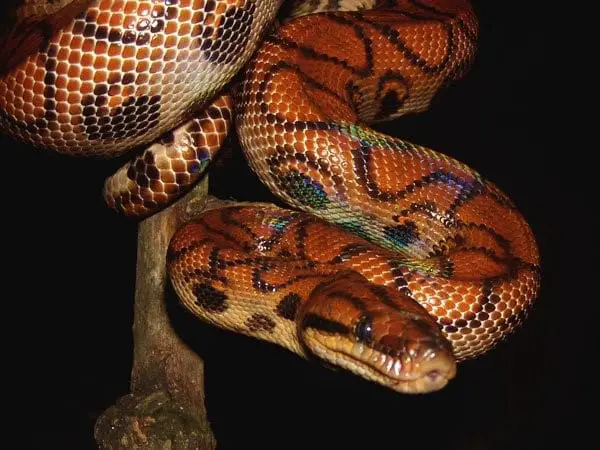
Place a dish of clean water in the tank. Your rainbow boa will simply slide inside the dish to have a drink of water. The water dish must be made of ceramic or clay but not plastic. You may also spray the tank with water in a mister. The boa will lick the vapor off the side of the tank or on plants.
Check the humidity inside the tank constantly. Use the mister to spray water and increase moisture inside the tank.
Availability – Where to Get One?
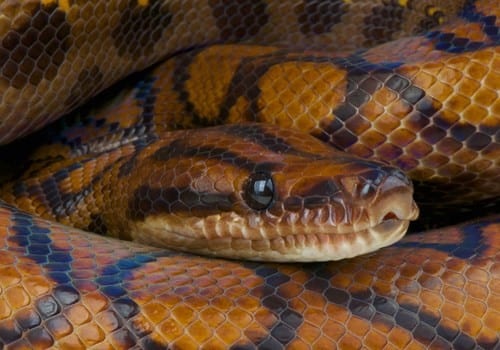
You can get a Brazilian rainbow boa from a local pet store or from an online reptile shop. Buy your pet from a reputable dealer or pet store to make sure your pet has good health. And before you take your pet home, asks for a certificate from the vet which is usually provided by the seller. Remember this as you buy other exotic pets.
A hatchling Brazilian rainbow boa cost around $200 online while an adult costs around $300. The price depends on the size, gender and shipment costs. You may also save money by purchasing a snake from a local breeder or dealer than purchasing from an online store.
How to Care for a Brazilian Rainbow Boa?
Caring for a Brazilian rainbow boa is no rocket science. Just provide it good food, the right lighting and humidity levels, and frequent vet visits and you’ll surely have a healthy, happy pet. Remember the following tips:
- Don’t forget to maintain tank cleanliness and neatness. Spot clean the tank daily, always change bedding weekly or more often and never reuse any material.
- Always monitor tank temperature and humidity with a digital thermometer and hygrometer.
- Place a dish of water inside the tank to hydrate the boa and to improve humidity inside the tank.
- Give your boa the best quality of food. Follow its natural diet of insects, arthropods, and lizards.
- Remember to hold your pet early so it will start warming up to you. Start during the juvenile stage; using steady hands calmly and steadily. This will also improve the confidence of the rainbow boa.
- Support the snake as it sheds. Maintain the ideal humidity levels by hydrating the tank using a mister. You may also soak the boa in warm water to help loosen dry, old skin and ease the shedding process. For any problems when shedding, consult your vet at once.
- Take your pet to the vet to consult any type of medical condition. Use basic first aid for simple cuts and bruises but all other conditions, consult a vet for proper care.
- When purchasing a rainbow boa from a pet shop, make sure to buy from a reputable, legal pet shop. Always ask for a medical certificate to make sure that your pet is healthy. Make sure that Brazilian rainbow boas are legal in your country or state before purchasing or ordering.
FAQs
How big do Brazilian rainbow boas become?
An adult rainbow boa can grow over 4 feet while there are monstrous specimens that can grow up to 7 feet in length. Rainbow boas also live longer and given the right conditions, may live up to 25 years.
Are rainbow boas poisonous?
Like all boas, rainbow boas are non-venomous. The way they kill their prey is through constriction. This boa may bite when they feel afraid or threatened; the bite is painful but is not dangerous.
Are rainbow boas aggressive snakes?
Brazilian rainbow boas are known to be more aggressive compared to the average boa. Therefore, you must socialize your boa and handle this carefully.
Will the bite of a Brazilian rainbow boa hurt?
Rainbow boas will not chew their prey but will only bite and release, According to experts, the bite of a rainbow boa does not hurt but will leave a nasty bruise along the bite mark or area.
Do rainbow boas require UVB light?
Rainbow boas are nocturnal creatures and thus will not need a UVB lamp to maintain its body temperature. UVB bulbs should be used during the light portion of the life cycle.
Does Brazilian rainbow boa sleep?
Because this boa is nocturnal, this will sleep in the mornings and hunt or eat during the evening. Be sure to keep the tank is installed in a quiet room or in a room where there’s less traffic.

